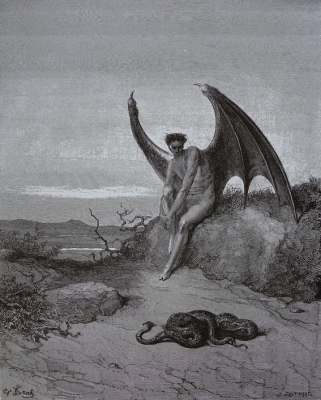Gospel in Art: How can Satan cast out Satan?

The Serpent.. Fast Sleeping, soon he found In labyrinth of many a round, self-rolled, by Gustave Doré, 1866, engraving for Milton's Paradise Lost. Cassell, Petter & Galpin © Wikimedia Commons.
Source: Christian Art
Gospel of 27 January 2025
Mark 3:22-30
At that time: The scribes who came down from Jerusalem were saying, 'He is possessed by Beelzebul,' and 'By the prince of demons he casts out the demons.' And he called them to him and said to them in parables, 'How can Satan cast out Satan? If a kingdom is divided against itself, that kingdom cannot stand. And if a house is divided against itself, that house will not be able to stand. And if Satan has risen up against himself and is divided, he cannot stand, but is coming to an end. But no one can enter a strong man's house and plunder his goods, unless he first binds the strong man. Then indeed he may plunder his house.
'Truly, I say to you, all sins will be forgiven the children of man, and whatever blasphemies they utter, but whoever blasphemes against the Holy Spirit never has forgiveness, but is guilty of an eternal sin' - for they were saying, 'He has an unclean spirit.'
Reflection on the engraving
You've probably heard the saying, "United we stand; divided we fall." One of the reasons we coped so well as a nation during the Covid pandemic a few years ago, was our unity in facing its challenges. People looked out for one another rather than simply prioritising their own interests. There was a strong sense of communal solidarity, with many making significant sacrifices not only for their own safety but also for the wellbeing of others. we were united in our fight, united in our grief.
In today's Gospel, Jesus states that a kingdom divided against itself cannot stand, and the same applies to a divided household. He makes this point in response to those who accused him of performing His miraculous works through the power of Satan. This accusation represents a profound misunderstanding of Jesus and his ministry. To attribute his life-giving actions to the power of Satan, rather than recognising the Spirit of God, at work in Him, is to misjudge Him entirely.
The depiction of Satan in art has undergone significant evolution over the centuries. In early Christian art, Satan was often represented symbolically, such as through the image of a serpent in the Garden of Eden or as a subtle shadowy figure, indicating his association with sin and temptation. By the medieval period, artistic depictions became more elaborate and explicit, with the devil frequently shown as a grotesque, monstrous figure designed to evoke fear. The devil was now being portrayed with composite features such as horns, tails, cloven hooves, drawing on pagan imagery to emphasise his otherworldly nature. During the Renaissance, depictions of Satan grew more sophisticated, with artists like Michelangelo exploring his character as a fallen angel, embodying also his moral and psychological decay.
One striking depiction of the devil can be found in Gustave Doré's 19th-century illustrations for Paradise Lost, where Satan is rendered as a tragic and imposing figure, blending physical beauty with moral decay. This duality marked a shift from purely grotesque imagery to a more complex portrayal, reflecting broader artistic and theological explorations of sin, free will, and redemption. In fact our engraving is a double portrait: Satan and also the snake, depicting two versions of the same evil one.
LINKS
Gospel in Art: https://christian.art/
Today's Reflection: https://christian.art/daily-gospel-reading/mark-3-22-30-2025/


















